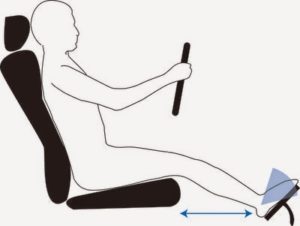Don’t let driving be a pain in the back!
Many of us spend more time sitting in the car than we’re aware of. Even a 30 minute commute to work can add up to 5 hours+ a week behind the wheel! This can be a source of real discomfort for many people, even those that aren’t struggling with a back injury.
This is something I’m often asked about, so here are my top 5 tips for improving your driving posture:
1. Adjust your seat
Get your leg position right
Ensure that your:
- legs are not cramped up
- knees are slightly bent
- feet are comfortably on the pedals (i.e. you’re not reaching for them)
- your thighs are relaxed
Tilt your seat
Ensure that you:
- tilt the seat so that your entire thigh is supported evenly
- avoid having the backs of your knees in contact with the seat
Adjust the seat angle
Aim for:
- a 100-110 degree angle between your hips and your back
- your shoulders to be behind your hips, not directly in line/above them.
Adjust your seat height
Aim to lift the seat:
- so your chin is in line with the top of your steering wheel
- so your hips are as high as your knees, but not so that your knees interfere with the steering wheel
Add a lumbar support
Whether it be your car’s inbuilt lumbar support or a lumbar support cushion you add to your seat, ensure it:
- sits in the small of your lower back
- supports the curve in your lower back gently, but does not push you forward.
2. Aim for 9 and 3
Most of us were told to hold the steering wheel at 10 and 2 while driving, however holding the wheel at 9 and 3 will allow your shoulders to relax and take pressure of your neck. Also avoid crossing over to grab the right side of the wheel with your left hand and vice versa – this will place unnecessary strain on your shoulder joints.
3. Don’t sit on your wallet
Make sure you remove your wallet/phone from your back pocket to avoid isolated pressure areas or asymmetrical positioning of your pelvis.
4. Take frequent breaks
If you’ve got a long drive ahead of you, plan to have a break at least every 2 hours. Once you reach your destination, give yourself a couple of minutes before attempting to lift anything out of the boot (like a pram or suitcase) or before sitting again (i.e. at work or on the couch at home)
5. Give your body a stretch
When you stop for a break on a long drive or at the end of any drive, do your body a favour and give it a quick stretch. The following stretches will help to ease any tension that has built up and help prevent back pain from developing:
Hip flexor stretch:
- tuck tailbone under
- hold 30 seconds
- repeat both sides
Lumbar rotation stretch:
- lie on back
- take one knee across body with opposite hand
- hold 15 seconds
- repeat both sides
Lumbar extension:
- lie on tummy
- slowly push up onto hands, allowing hips to sink towards the ground
- only lift to elbows if extending onto your hands is too uncomfortable
- hold 30 seconds
Recommended reading from Glow
3 signs your neck is giving you headaches
5 habits for a happy, healthy spine!
Should I crack my own back?
Which mattress should I buy?
